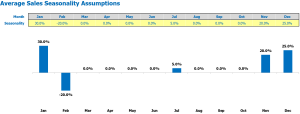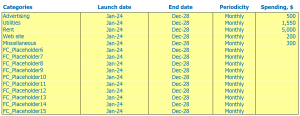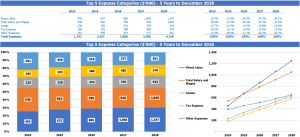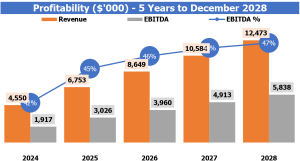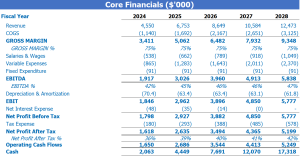- Home
- Sales and revenue
- Running costs
- Financial
Welcome to our guide on how to build a financial model for a pharmacy. As a critical component of the healthcare industry, pharmacies play an important role in providing healthcare services to millions of people. However, running a pharmacy business can be difficult if you don’t have a financial model in place. In this article, we’ll explore the importance of pharmacy financial planning and management, and how you can use financial projections and metrics to assess your pharmacy’s financial performance. With our guide, you will be able to create a pharmacy business plan that can help you build a sustainable and profitable pharmacy business.
Pharmacy revenues and sales forecasts
Revenue and sales forecasts play a key role in the success of a pharmacy business. A comprehensive pharmacy financial model that includes projected financials and performance metrics can help pharmacy financial management make informed business decisions. To create a reliable forecast, it is necessary to consider several factors such as launch date, ramp-up time, walk-in traffic and growth assumptions, customer and purchase assumptions, seasonality of sales and other critical parameters.
Pharmacy launch date
Choosing a launch date for your pharmacy is a critical decision that can have a huge impact on your financial performance. This date will not only affect all aspects of your pharmacy operation, but also your financial estimation and forecasting. Therefore, choosing the right launch date for your business is essential.
Your launch date is a key consideration when creating your pharmacy’s financial model. The financial model should support your expenses, income statement, cash flow statement, and balance sheet, and more importantly, it should be designed to be possible and achievable within the timeline.
Selecting a launch date will help you organize and plan everything in terms of timing, such as licenses, vendor contracts, hiring staff, and equipping the facility with equipment. and the necessary systems. Without a launch date, you could risk uncoordinated activities, which could lead to avoidable expenses.
Tips & Tricks
- Review your Financial Pharmacy Business Plan to find out what you can afford to spend before and after the launch date.
- Create a complete pharmacy financial plan that outlines all activities prior to the launch date and their cost.
- Perform a pharmacy financial analysis to determine the best time to launch your pharmacy based on cash flow and expenses.
Before launching your pharmacy, you should understand your pharmacy’s financial statements to ensure that your pharmacy’s financial projections align with your overall pharmacy business plan. The launch date will significantly affect all of these aspects, and poor planning could lead to poor financial performance. Therefore, select a date that will allow you to create a solid foundation for your pharmacy to achieve your financial metrics and goals.
Rise time in pharmacy
When starting a new business, it is crucial to create a comprehensive financial plan that includes pharmacy financial projections , pharmacy financial analysis , and pharmacy financial management . An important factor to consider when forecasting sales is the ramp-up time to the sales plateau .
Ramp-up time refers to the period it takes a business to reach its maximum sales potential. During this time, a business will experience increasing sales and revenue, which will eventually flatten out to its maximum level. Understanding ramp-up time is crucial for effective forecasting and planning as it impacts pharmacy revenue model .
What is the ramp-up period for your business? This is how long your business will need to reach the sales plateau. In your industry, it may be three to six months, depending on factors such as location, competition, and marketing efforts.
Tips & Tricks:
- Conduct market research to determine typical ramp-up time for your industry and location.
- Develop a comprehensive marketing plan to increase brand awareness and drive sales during the ramp-up period.
- Track key performance metrics, such as new customer acquisition and revenue growth, to monitor progress and adjust strategy as needed.
In conclusion, understanding sales plateau time is an essential part of pharmacy financial planning , as it impacts the overall financial performance and success of a business. By incorporating this information into your financial projections and analyses, you can make more calculated decisions and set achievable goals for the future.
PHARMACE WACK-IN TRADICTS
After the six-month ramp-up period, the daily average daily traffic for Monday through Friday is 125 visitors, while Saturday and Sunday is 175 visitors. This contribution is crucial to creating the pharmacy revenue model. Walk-in traffic represents potential customers, and this data provides insight into market size and opportunities to capture greater market share.
Based on past trends, the average dating traffic growth factor is 5% per year. So in year one, the average walk-in traffic for weekdays would increase to 131 visitors, and on weekends it would increase to 183 visitors.
The financial model uses this growth rate to predict future dating traffic for each day of the week over the next five years. This data helps determine staff planning, inventory management, and marketing initiatives to increase customer foot traffic and increase revenue.
Tips & Tricks:
- Use local demographics to more accurately estimate walk-in traffic
- Track daily traffic numbers to adjust forecasts accordingly
- Conduct customer surveys to understand why they choose your pharmacy over competitors or what services can be improved
Overall, understanding walk-in traffic inputs in terms of days of the week and growth rates is necessary to drive pharmacy financial planning, management, analysis, projections, and performance . The financial model is an essential tool for anticipating potential opportunities and making informed decisions to optimize profitability.
Pharmacy visits for sales conversion and repeat sales entries
When it comes to pharmaceuticals, getting visitors to become customers is no easy task. The good news is that a pharmacy can become a profitable business if the pharmacy business plan is well thought out. Among Pharmacy Financial Projections, Pharmacy Financial Analysis, Pharmacy Financial Planning, Pharmacy Financial Management, Pharmacy Financial Forecast, Pharmacy Financial Statements, Pharmacy Financial Metrics, and Pharmacy Financial Performance, it is important factor pharmacy visits into sales conversion and sales input.
The visit conversion rate is essential in determining the number of visitors who turn into new customers in the pharmacy. For example, a pharmacy that registers 20 visitors per day, and 50% of them turn into real customers, will have 10 new visitors per day. In this case, the conversion rate is 50%. Also, repeat sales entries will help calculate the monthly amount of purchases that each customer will repeat. If a regular customer buys from the pharmacy 2 times per month and spends an average of per visit, the amount of repeat sales input is 0 per month in total sales per regular customer.
Tips & Tricks
- Offer promotions that can entice visitors to become customers, such as a discounted price on their first purchase.
- Ensure excellent customer service to maximize the chances of repeat sales, creating a friendly and helpful environment.
- Keep in touch with customers to remind them of pharmacy services and products via newsletter or promotional emails.
These two parameters are essential assumptions in terms of building a financial model for pharmacy. By taking a closer look at conversion rates and repeat sales, it is possible to predict pharmacy revenue model, improve pharmacy performance, and create a successful pharmacy business plan.
PHARMACEUTICAL SALES SALES INPETATIONS
In our pharmacy store, we carry a variety of products from different categories such as prescription drugs, over-the-counter drugs, health supplements, beauty and personal care items, and medical equipment. To better plan and predict our Pharmacy financial projections , it is essential to determine the sales mix by product category.
Entering sales mix assumptions on the product category lever will be easier to understand. For example, let’s say we have five product categories: prescription drugs, over-the-counter drugs, health supplements, beauty and personal care, and medical equipment. We assume that the sales mix for the first year forecast will be as follows:
- Prescription drugs: 40%
- Over-the-counter drugs: 25%
- Health Supplements: 10%
- Beauty and personal care: 20%
- Medical equipment: 5%
This means that of our total sales, 40% of prescription drugs, 25% of over-the-counter drugs, etc. These Pharmacy financial metrics provide valuable information that we can use to make important business decisions.
Tips & Tricks
- Regularly review your sales mix assumptions and adjust them if necessary.
Average pharmacy with average sale of inputs
In our store, we sell a variety of drugstore products that fall into specific product categories such as over-the-counter drugs, prescription drugs, and health and wellness products.
When it comes to financial planning for our pharmacy, we find it much easier to capture assumptions at the product category level rather than at the product level. An important assumption is the average sales amount by product categories and by years.
For example, let’s say we have three product categories: over-the-counter drugs, prescription drugs, and health and wellness products. We can estimate the average sale amount for each of these categories by analyzing historical data and trends. We could estimate that the average sale amount for over-the-counter drugs is , prescription drugs are , and health and wellness products are .
Using the sales mix and average sale amount of each product category, our pharmacy revenue model will calculate the average ticket size. This is an important metric that helps us understand how much our customers are spending on average per visit.
Tips & Tricks:
- Regularly update and revise your assumptions for the average sale amount to ensure they are still accurate and relevant.
- Consider offering bundles or bundles of products to increase the average ticket size.
Pharmacy sales seasonality
Sales seasonality refers to the fluctuation of sales revenue throughout the calendar year. Understanding the seasonality of your pharmacy sales can help you project future revenue and budget accordingly.
Seasonal factors differ depending on the nature of your pharmacy, but some common patterns include increased sales during cold and flu season and decreased sales during the summer months.
Here is an example: Suppose your average monthly sales per day are 00. During the winter months, sales may increase by 5% due to an increase in cold and flu cases. Therefore, your predicted sales for January and February would be 50 per day. Conversely, during the summer months, sales can decrease by 10% due to holidays and less foot traffic. Therefore, your forecasted sales for June, July, and August would be 0 per day.
Tips and tricks:
- Keep track of sales data over time to identify patterns and better predict future revenue
- Tive based on external events that can influence sales such as holidays or community events
- Consider adjusting inventory levels based on projected sales to optimize financial performance
Understanding your pharmacy’s seasonal sales patterns is key to effective financial planning and management. By accounting for seasonal fluctuations, you can better project revenue and adjust your business plan finances accordingly.
Pharmacy Operational Expenditure Forecast
Operational expense forecasts are a crucial part of the pharmacy financial model. It includes a detailed estimate of the expenses required to effectively manage the pharmacy business. Expenses include cost of goods sold by products %, wages and salaries of employees, rent, lease or mortgage payment, utilities, and other operating expenses.
| Exploitation charges | Amount (per month) Ranges in USD |
|---|---|
| Cost of goods sold by products % | ,000 – ,000 |
| Salaries and wages of employees | ,000 – ,000 |
| Rent, lease or mortgage payment | ,000 – ,000 |
| Public services | ,000 – ,000 |
| Other running costs | ,000 – ,000 |
| Total | ,000 – ,000 |
Pharmacy cost of goods sold
Pharmacy financial management requires an understanding of pharmacy financial statements, pharmacy financial metrics, pharmacy financial forecasts, pharmacy financial projections, pharmacy financial analysis, and pharmacy financial planning. This requires knowledge of pharmacy revenue model and business business plan.
The pharmacy cost of goods sold (COGS) represents the cost of drugs sold in a pharmacy. COGS serves as a measure of the direct costs incurred in the production of goods sold by the pharmacy industry. The COG percentage varies by product category.
Cost of Goods Sold Assumptions:
-
Average retail price (ARP) for each product category.
-
Wholesale Acquisition Cost (WAC) for each product category.
-
Redemption Price (RP) for each product category.
-
Inflation rate assumptions.
-
Gross margins (profit for each product category)
Percentage of COG for product categories:
-
Branded drugs – 25%
-
Generic drugs – 20%
-
Over-the-Counter (OTC) Items – 35%
-
Durable Medical Equipment – 45%
Tips & Tricks
-
Regularly monitor inventory turnover and reorganize regularly to avoid excess inventory.
-
Consider partnering with drug manufacturers to negotiate better prices and discounts.
-
Explore sales data to identify products with high profit margins to allocate more resources.
Salaries and wages of pharmacy employees
According to our Financial Pharmacy Business Plan , we have calculated salaries and wages for various positions. Our staff/positions will be appointed as:
- Pharmacist – hired from the start – earns 0,000 annually
- Pharmacy Technician – hired after 3 months – earns ,000 annually
- Cashier – hired after 6 months – earns ,000 annually
We will hire one full-time pharmacist, two full-time pharmacy technicians and two full-time cashiers per year. These positions will keep our pharmacy running smoothly and help us achieve our Pharmacy Financial Performance choice.
Tips & Tricks:
- Before making any financial assumptions, it is important to estimate the number of employees needed to run the pharmacy.
- Always consider employee wages and salaries while doing a pharmacy financial analysis .
Pharmacy rent, lease or mortgage payment
One of the crucial Pharmacy financial metrics that affect the Pharmacy revenue model is the rent, lease, or mortgage payment. Pharmacy planning depends heavily on these assumptions, and it’s important to create a financial pharmacy business plan that can accommodate them.
When it comes to creating a Pharmacy Financial Management plan, it’s important to understand the differences between rent, lease, and mortgage payment. Rent is usually a monthly payment made to a landlord, while a lease is a long-term contract that usually lasts for several years. Mortgage payments, on the other hand, are made on the principal balance of the pharmacy loan.
Tips & Tricks:
- Research and compare different real estate options before making a decision on rent, lease or mortgage payment.
- Factor in future growth potential when deciding the length of a lease.
- Review the terms and conditions of a loan before accepting the mortgage payment
All in all, creating a pharmacy financial plan that takes rent, lease, or mortgage payment into account is essential for long-term success in the industry. With proper Pharmacy Financial Analysis and Pharmacy Financial Projections , pharmacy owners can make informed decisions that will improve their pharmacy financial performance and increase revenue.
Public pharmacy services
One of the Pharmacy Business Plan Financials that you need to consider is pharmacy revenue model which is heavily influenced by pharmacy utilities . These utilities can be a significant portion of your overhead costs as a pharmacy owner.
Pharmacy utilities refer to essential services that help maintain your pharmacy business such as electricity, water, gas, internet, and telephone services. As the pharmacy owner, you should account for these expenses in your Pharmacy Financial Planning and include them in your Pharmacy Financial Projections .
Tips & Tricks:
- Consider renegotiating your utility contracts to get better rates.
- Invest in energy efficient appliances and practices to reduce electricity and water bills.
- Use online communication services to minimize phone bill expenses, especially if you have more than one location.
When creating your pharmacy financial statements , it is crucial to include all of your pharmacy financial metrics , including pharmacy utility expenses. This data will help you accurately determine your pharmacy’s financial performance so you can make strategic decisions to improve pharmacy financial management and forecasting capabilities.
Pharmacy Other operating costs
Aside from the pharmacy revenue model and pharmacy financials , it’s also important to consider the other costs of running your pharmacy business when building your financial model. These costs are usually overlooked but can significantly affect the profitability and success of your business.
Examples of other operating costs that should be included in your pharmacy financial projections are rent, utilities, insurance, inventory, and employee benefits. These are costs you need to pay regularly to maintain your business operations and keep your employees happy.
Ignoring these pharmacy financial metrics can significantly affect your pharmacy financial performance , so it’s important to incorporate them into your pharmacy financial analysis . By being aware of these expenses, you can better plan and adjust your price for drugs or services to ensure that you cover all of your business costs and earn a reasonable profit.
Financial Pharmacy Forecast
Financial pharmacy forecasting is an essential part of any successful pharmacy business plan. It is all about predicting future income, expenses and other financial transactions in the pharmacy industry. This type of forecast can help pharmacists better understand their pharmacy financial performance and identify opportunities for growth. It typically includes a profit and loss statement, sources and uses of the report, and other financial projections that can help pharmacy owners better manage their resources and achieve their strategic goals.
Pharmacy profitability
Once we have built projections for revenues and expenses using the pharmacy revenue model and the pharmacy business plan, we can move on to evaluating the profitability of the pharmacy. This assessment is crucial because it helps us understand how well the pharmacy uses its resources, including human and financial.
To assess the profitability of the pharmacy, we need to check the profit and loss (P&L) from revenue to net profit. This will help us visualize the “profitability” of the pharmacy, such as gross profit or EBITDA margin. By analyzing these metrics, we can identify areas where we need to improve pharmacy performance.
Tips & Tricks:
- Use pharmacy financial statements and pharmacy financial metrics to understand your pharmacy’s financial health.
- Use pharmacy financial forecasting and pharmacy financial analysis to make informed decisions about the future of your business.
- Use pharmacy financial management and pharmacy financial planning to manage your pharmacy cash flow and ensure you have enough funds to run your business.
By leveraging pharmacy financial projections, we can create a solid foundation for our pharmacy’s financial performance. With accurate projections and financial analysis, we can make informed decisions about where our business is going and stay ahead of the competition.
Pharmacy Sources and Use of the Chart
The Sources and Uses of Funds in the Excel Financial Model for Pharmacy provides users with an organized summary of where capital will come from sources and how that capital will be spent in uses. It is important for the total amounts of sources and uses to be equal to each other. Disclosure of sources and uses is particularly critical when the company is considering or going through recapitalization, restructuring, or mergers and acquisitions (M&A).
- Pharmacy Revenue Model: Create a clear revenue model that outlines your pharmacy revenue sources.
- Pharmacy Business Plan Financials: Prepare a comprehensive financial plan that contains financial statements such as balance sheet, income statement, and cash flow statement.
- Pharmacy Financial Projections: Project your pharmacy’s financials using realistic assumptions and data.
- Pharmacy Financial Analysis: Analyze your pharmacy’s financial performance, which involves using ratios and other financial metrics.
- Pharmacy Financial Planning: Develop a financial plan for your pharmacy that considers factors such as competition, market trends, and customer demand.
- Pharmacy Financial Management: Manage your pharmacy finances, including cash flow, expenses, and income.
- Pharmacy Financial Forecasting: Use forecasting techniques to estimate your pharmacy’s future financial performance.
- Pharmacy Financial Statements: Prepare financial statements such as balance sheet, income statement, and cash flow statements that provide insight into your pharmacy’s financial health.
- Pharmacy Financial Metrics: Use financial metrics such as ROI, ROA, and ROE to measure your pharmacy’s financial performance.
- Pharmacy financial performance: Continuously monitor your pharmacy’s financial performance and take corrective action if necessary.
In conclusion, building a Financial Model for a pharmacy is a crucial aspect of managing pharmacy finances. It enables owners and managers to make informed financial decisions, identify opportunities for growth, and ensure the long-term sustainability of the pharmacy. Creating a comprehensive pharmacy financial business plan that includes detailed pharmacy financial projections , pharmacy financial analysis , pharmacy financial planning , pharmacy financial management , and pharmacy forecasting is essential for estimating pharmacy financial statements , pharmacy financial metrics , and Pharmacy Financial Performance . With an effective financial model in place, pharmacists can better navigate the complexities of the industry and put their business to success.







